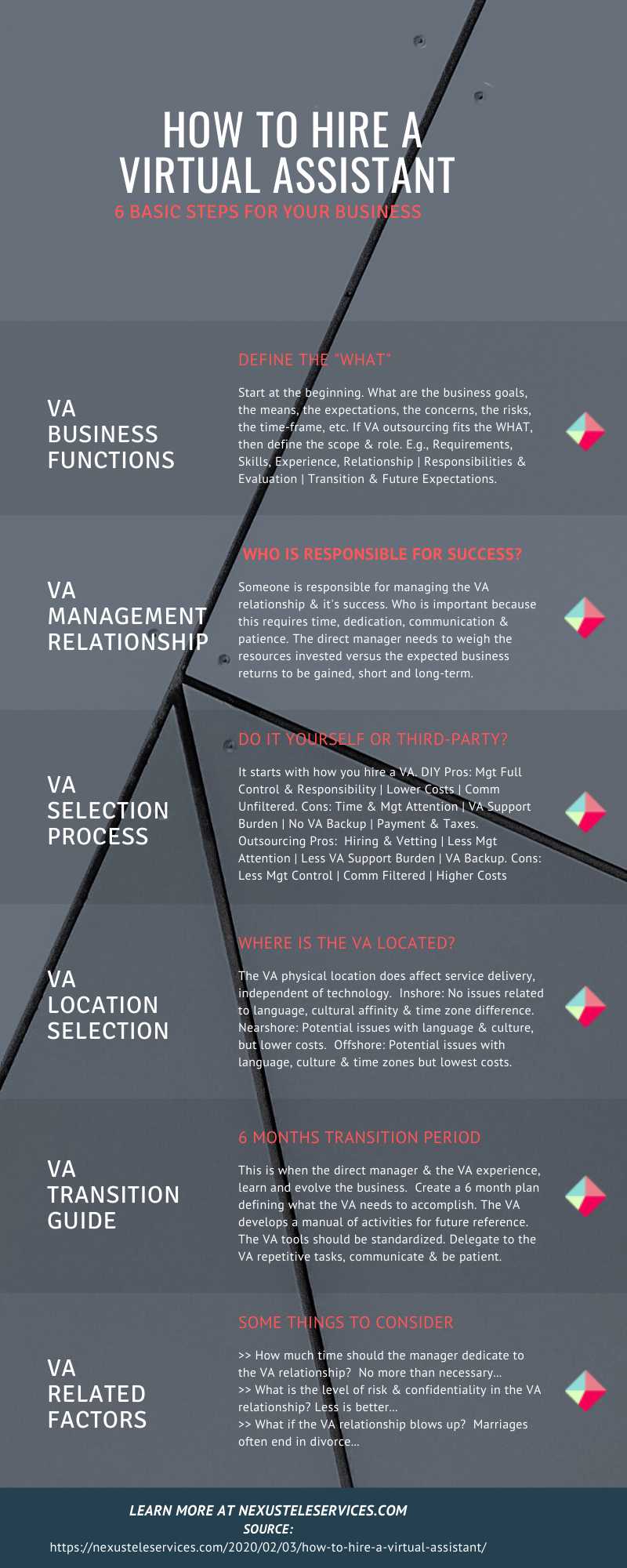How To Hire A Virtual Assistant - Business Owner Guide
When you decide to hire a virtual assistant, you have made a decision to outsource some aspect of your business functions. Accordingly, whether your business is a one-person shop, a small team starting, or an established company, this decision requires thought, planning, and execution. Following is a business owner guide on how to hire a virtual assistant that will result in achieving your desired goals and long-term success for your business.
Before moving forward, let’s do a quick review of the WHAT and WHY of virtual assistant services. Firstly, a virtual assistant (VA) is often an independent contractor who provides services to one or more business clients from a remote location. Secondly, virtual assistant services are remarkably broad but can be categorized as administrative, creative and technical in nature and offer a variety of potential benefits for a business owner.
Share this Image On Your Site
How To Hire A Virtual Assistant Overview
1 – Define Business VA Outsourcing Functions
The basic credo of how to hire a virtual assistant is to start at the beginning and defining the WHAT. Basically what are the business goals, what are the means, what are the expectations, what are the concerns, what are the risks, what is the time-frame, etc. Because answering this most basic question will help you decide whether using virtual assistant outsourcing services is aligned and fits WHAT your business needs.
If virtual assistant outsourcing fits the WHAT, you then need to define the scope and functional role of the VA. Firstly it starts with a clear functional description of the role, relationship with internal staff, requirements, skills and work experience, etc. Secondly, define the specific VA role responsibilities and means of evaluating. Thirdly, define stages of VA role transition based on accumulated experience, short and long-term. Fourthly, this serves to provide transparency in your communication with a VA, setting the proper expectations in the future.
Let’s consider a simple business example.
WHAT
- The company is an established construction company.
- Its goal is to expand its customer base and increase sales through local marketing activities and social media presence.
- The company needs to service marketing and social media responses directing them to the company sales staff for follow-up.
FUNCTIONAL ROLE (Short-Term)
- Marketing sales support administrator, reporting to company Sales Manager.
- Process customer prospect inquiries from marketing activities via telephone, chat, email, and social media.
- Prequalify customer prospects and schedule conference calls with company sales staff via cloud calendar system. Follow up as required.
- Time frame 1-6 months.
FUNCTIONAL ROLE (Long-Term)
- Above, plus contacting existing company customers for new business opportunities and personal referrals.
- Coordinating Email marketing activities, newsletter publication, and website/social media company portfolio of projects for marketing activities.
- Generate performance reports of marketing activities, sales results, cost per investment, etc.
- Time frame 6+ months.
EXPECTATIONS
- Trustworthy, reliable, no excuses, excellent verbal skills (English & Spanish).
- Good organizational, time management, computer, and Internet skills.
- Strong listening skills and patience in dealing with personnel and prospects.
- Ability to think “outside the box” and crash through company roadblocks.
- 1+ year experience in inside marketing/sales support
- Experience in MS-Excel, Word, Google Docs, Social Media.

2 – Determine Management VA Relationship
A factor related to how you hire a virtual assistant is determining WHO is responsible for the success in the VA business relationship. Generally, the WHO is the direct manager tasked with supervising the virtual assistant.
In the case of a small business, the direct manager is often the owner or senior manager. However, this may not be the case in larger companies. Consequently, the dynamics in the VA business relationship will be different due to the distance between WHO made the decision, and WHO has the responsibility for its success.
Why does this matter? Because, whether a local direct employee or remote virtual assistant, management responsibility requires time, dedication, communication, and a healthy dose of patience. So, the direct manager needs to weigh the resources invested in the VA relationship versus the expected business returns to be gained, short and long-term.
Some factors the Virtual Assistant direct manager should consider.
Control | Micromanaging | Hands-Off
Loss Of Control – Outsourcing of responsibilities to a Virtual Assistant implies a loss of control because the business process is now performed remotely and personal supervision is more difficult. Correspondingly, is the direct manager experienced and prepared for this transition?
Micromanaging – Does the direct manager have a tendency to micromanage delegated responsibilities (particularly remotely performed)? In effect the direct manager becomes a bottleneck in the process, reducing productivity and potential benefits of the VA’s activities.
Hands-Off Management – Once the Virtual Assistant relationship is initially “set up”, does the direct manager have more of an absent, hands-off, let me know when you have issues, management style? In that case, the out of sight, out of mind limited communication and feedback hinders the development of the VA to better serve the business needs
Trust | ROI
Develop Trust – How does the direct manager develop trust with a remote, sight-unseen Virtual Assistant? While trust is obviously a two-way street, the direct manager needs to be the initiator to foster its development. Hence achieving better communication, teamwork, and performance of the VA toward the business goals.
Cost Versus Investment – A Virtual Assistant has a defined role, with responsibilities and tasks to be performed. Equally, the VA is a PERSON with a mind who can think for himself or herself. Furthermore, if nurtured through constructive feedback and positive encouragement, the VA can evolve and grow to be a significant contributor to the success of the company. Consequently, does the direct manager view the VA as a business COST (a numbers person) or a business INVESTMENT (a people person)?

3 – How To Hire A Virtual Assistant – Selection
As you would expect it all starts with how you hire a virtual assistant. Basically, you have to decide whether you Do-It-Yourself (DIY) or whether you use a third-party Virtual Assistant Services provider. In either case, like any business decision, there are pros and cons.
Let’s discuss each below in greater detail.
Do-It-Yourself Hire A Virtual Assistant Selection
DIY PROS
- The direct manager has full control, responsibility, and accountability of the process.
- Selecting of VA candidates is limited only by the direct manager’s time and patience.
- Communication and performance review between the business and the VA is unfiltered by a third-party.
- The cost per VA service transaction may be lower.
- Quality of VA services may be higher depending upon the various factors and degree of direct manager oversight.
DIY CONS
- More time and management attention by the direct manager is invested in finding and vetting VA candidates.
- Supervision of the selected VA will require more time and oversight by the direct manager.
- The VA will have less infrastructure, technology, and skill resources available to perform services.
- The business will be responsible for VA payment administration and tax reporting.
- A business continuity plan for changes in VA status (absence due to sickness, personal leave, or other reasons) will be limited or not exist. Consequently, this will result in a restart of the VA selection cycle or the movement of services in-house to the business.
Third-Party Provider Hire A Virtual Assistant Selection
THIRD-PARTY PROS
- The third-party provider has direct control of the VA’s activities, subject to direct manager guidelines and approval.
- Finding and vetting VA candidates is a third-party provider value-added service. Consequently, less time and management attention is required by the direct manager, subject to the final approval of the candidate.
- Supervision of the selected VA will require less time and oversight by the direct manager.
- The third-party provider will provide the VA with more infrastructure, technology, and skill resources to perform services. As a result, this may produce lower costs per service transaction and improved quality.
- The third-party provider will be responsible for VA payment administration and tax reporting.
- A business continuity plan for changes in VA status will exist and be more flexible since there will be multiple VAs providing services to multiple clients. Consequently, this will eliminate a restart of the VA cycle.
THIRD-PARTY CONS
- Communication and performance review between the business and the VA is filtered by the third-party provider.
- The cost per VA service hour may be higher.
- Quality of VA services may be lower depending upon various factors and less direct manager oversight.

4 – How To Hire A Virtual Assistant – Location Selection
The selection of the Virtual Assistant inherently includes the selection of the physical LOCATION of the VA. While the Internet, broad array of technologies, and online tools provide a high degree of transparency of location, there are differences in service delivery that should be noted. In brief the VA location may be inshore (in country), nearshore (close to country) and offshore (long distant from country).
Let’s discuss the different location options in greater detail.
How To Hire A Virtual Assistant – Inshore Location
The first selection option is an inshore (in-country) Virtual Assistant location that is straightforward for a business. Being that there are no issues related to language, cultural affinity, and time zone difference. However, the business is not likely to gain VA labor cost savings as the following alternatives.
How To Hire A Virtual Assistant – Nearshore Location
Moving further away, the second selection option is a nearshore (close to country) Virtual Assistant location. For example, locations such as Canada, Mexico, Central America, and the Caribbean. Because of potential issues related to language and degree of difference in cultural affinity, a business will require further investigation and considerations.
As an example, if the VA function requires high-level verbal contact with a company’s clients, cultural affinity is important. While time zone differences are a neutral factor in service delivery.
Conversely, if the VA function is off-line social media, the location choice may be perfect. In that case, the business does gain VA labor cost savings.
How To Hire A Virtual Assistant – Offshore Location
The third selection option is an offshore (far from the country) Virtual Assistant location. For example, India, the Philippians, and Eastern Europe. Similarly to the above, with greater distance from the business location, there are potential issues related to language, differences in cultural affinity, and time zone differences.
Correspondingly a business will require its investigation and due diligence. Finally, an offshore location offers VA labor costs savings similar to a nearshore location.
Finally, there are other factors to be taken into consideration including political stability, environmental risks, availability of labor force, etc.
DISCLOSURE: Nexus Teleservices is a Nearshore Virtual Assistant Services business provider.

5 – Short-Term Virtual Assistant Transition Guide
How to hire a Virtual Assistant really takes solid form during the the first six months of the business relationship. Basically, this transition period is when the direct manager and the VA experience, learn and evolve in the cold, real world of business. All things considered, the business relationship will either reach its potential rewards or alternatively crash and burn with frustration and disappointment by both parties.
As has been noted, the direct manager is chartered with the success of the VA business relationship. So, as a former president once succinctly stated: “the buck stops here”.
The following transition guide offers you recommendations on how to reach the potential rewards of your VA relationship.
DEVELOP A SIX MONTH PLAN
As the direct manager, you probably have had several years to learn your business and what the Virtual Assistant needs to accomplish. So, develop a written plan (1, 2, 3, and 6 months) that phases in performance expectations so that both of you can succeed. Basically, what is critical for the VA to accomplish in 30 days that will then serve as a foundation to build upon moving forward?
CREATE A VA SYSTEM MANUAL
All Virtual Assistant repetitive processes need to be documented for future reference. Basically, you can do the draft or provide verbal guidelines that the VA can transcribe and execute in the process. For example, document all provider credential information, appointment setting guidelines, procedures to upload files and correspondence, etc. Alternatively, you can use online videos to coordinate training with the VA.
What are the benefits of creating a VA system manual? Chiefly it serves as an evolving information library for any future Virtual Assistant, facilitating easy transition and avoiding reinventing the wheel. Also, this allows you and the business functions to be more productive since this leverages the VA’s talents and creativity, enabling the VA to succeed.
As the direct manager, you should define the tools to be used in developing the VA system manual. For example, you might want to consider Evernote and Trello.
STANDARDIZE ON THE VA TOOLS
As has been noted, using the right tools can improve the process of communicating and training a new Virtual Assistant. Accordingly, the direct manager should standardize the toolset. Additionally, these tools should also encompass the broadest scope of business personnel that might communicate with the VA.
Examples include Dropbox or Evernote for easy access to files and information, Jing or Screenr to create online training video tutorials, and Trello or Asana for managing and staying up to date with tasks and tracking workgroup progress. Here is an extended list of tools by category that a Virtual Assistant can use to improve communications and productivity.
DELEGATE REPETITIVE TASKS
You need to honestly assess what should be delegated to the Virtual Assistant. As has been noted, most business tasks that are repetitive and routine in nature should be assigned to the VA. Consequently, this frees up more of your time to focus on more urgent and important business tasks.
Remember that each delegated activity should be documented by the VA in the system manual. In a word, when in doubt, prioritize and delegate to the Virtual Assistant.
COMMUNICATE AND ENCOURAGE QUESTIONS
Clear and consistent communications can resolve many issues in business as well as one’s personal life. Consequently, for the direct manager, the challenge lies in determining the proper balance of frequency, honesty, constructive feedback, transparency, and directed questions to the VA.
Additionally, you need to encourage the Virtual Assistant to proactively ask questions of you, without fear of being judged stupid or incapable of meeting expectations. For these reasons, this will save time for everyone long term and minimize the tasks that need to be redone.
BE KIND | BE PATIENT | USE THE TELEPHONE
Virtual Assistants are people. Accordingly, treat the VA with respect and be gracious in their contributions to inspire improvement, loyalty, and long-term growth. Really, this is basic Management 101, just from a remote distance.
There is no substitute for the human voice. Before there were email and chat, there was the sound of the telephone ringing signaling something important in the business day. So, use it when a new task is to be assigned to the VA, provide a five-minute overview, and allow for questions. Later follow up with the VA in written form with the details.

6 – How To Hire A Virtual Assistant – Considerations
This business owner guide on how to hire a virtual assistant provides an overview for managing a successful VA business relationship. However, there are a variety of Virtual Assistant services considerations that don’t conveniently lend themselves to simple pat answers.
Let’s review each in greater detail.
How Much Time And Resources Should The Manager Dedicate To Managing The Virtual Assistant?
The simple answer is no more than is necessary to allow the Virtual Assistant to achieve the defined business goals. Certainly, this response can be viewed as short-sighted, since no provision is made for investing more to develop a stronger VA that can evolve and contribute toward higher business goals.
However, personnel development is rarely the justification to use VA outsourcing services since it is invariably related to either labor cost savings or filling a skill need vacancy.
What Is Level Of Confidentiality And Risk To Be Assumed In A VA Relationship?
Less is better, from a business risk perspective. Whether it is credit card information, client lists, key vendor contacts, future business plans, new products, marketing and service development, intellectual property, etc. it is preferable to keep it in a limited number of hands as close to the home office as possible.
How Close Should A VA Have In The Client Relationship?
This is a challenge since there is a legitimate need for the VA to foster a good business relationship with an existing client. However, too close a relationship places the company at risk when the client does not distinguish the company from the VA relationship.
In this instance, it is probably preferable to rotate VA client responsibilities to re-enforce the business relationship with the client.
What If The VA Relationship Blows Up?
Some marriages end in horrible divorces with children scattered as casualties. Unfortunately the same can apply to a Virtual Assistant business relationship.
In this instance, move the business relationship back inside as quickly as possible, pick up the pieces in the relationship and look forward to a new day to start over.

How To Hire A Virtual Assistant Conclusion
Whether your business is a one person shop, a small team starting out, or an established company, the decision to hire a Virtual Assistant requires thought, planning and execution. Consequently, we have presented a business owner guide how to hire a Virtual Assistant that should help you be successful achieving your business goals.
Please call us at (888) 339-6699 to discuss how our nearshore virtual assistant services will serve your business needs or Contact Us.



Great very insightful